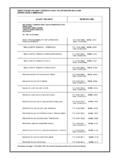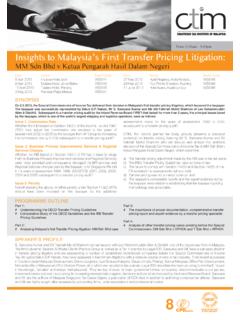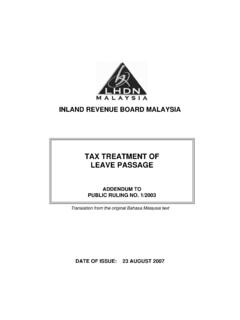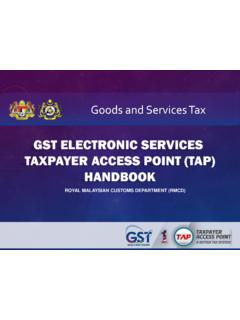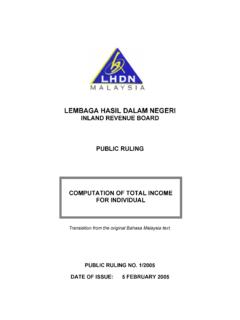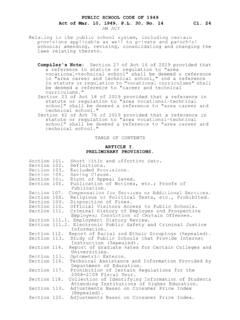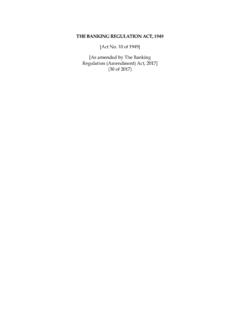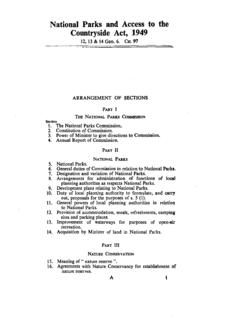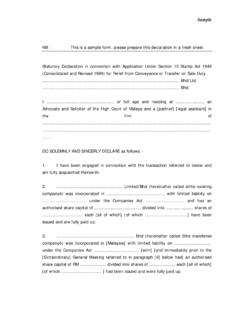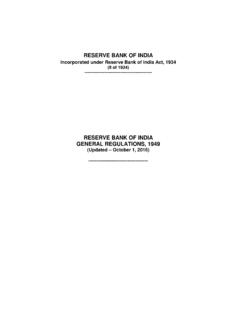Transcription of JOINT REVIEW OF THE STAMP ACT 1949 - CTIM
1 The Malaysian Institute of Certified Public Accountants JOINT REVIEW OF. THE STAMP ACT 1949. Prepared by: STAMP Duty Task Force JOINT REVIEW OF THE STAMP ACT 1949. Contents Page No. 1. Preamble 1. 2. Executive Summary 3. Salient Features And Information 1. 4. Materials Appended To This REVIEW 4. 5. Conclusion 4. Appendix 1A Proposals To Amend The Provisions Of The STAMP Act 1949 5. Appendix 1B Proposals To Regularise The Wordings And Provisions Of 17. The STAMP Act 1949. Appendix 2 A. Why Transaction-Based STAMP Duty Should Not Be Introduced In Malaysia 1. Introduction 24. 2. Brief Write-Up On SDRT And SDLT 24. 3. Impact Of SDRT On The UK Economy 25. 4. Impact Of SDLT On The UK Economy 28. 5. Back To The Homefront Malaysia 28. 6. Conclusion 29. Appendix 3 Comparison Of STAMP Duty Valuation Methods On The Transfer Of Private Limited Shares 1.
2 STAMP duty valuation methods adopted in 3 jurisdictions 30. 2. Issue 30. 3. Proposal 30. 4. Rationale 31. CTIM and MICPA. JOINT REVIEW OF THE STAMP ACT 1949. PREAMBLE: The Chartered Tax Institute of Malaysia (CTIM) and The Malaysian Institute of Certified Public Accountants (MICPA) are pleased to answer the call by the Inland Revenue Board (IRB) to look into ways to improve the Malaysian STAMP Act 1949 (MSA). Following the briefing by the IRB on 2 November, 2011, a STAMP Duty Task Force (SDTF) was formed, comprising representatives from various taxation firms, law firms, and members of the accounting and taxation bodies, to deliberate on the matter. The much appreciated input by the SDTF forms the basis of this paper, which represents the contribution by the institutes to the IRB. The SDTF understood that the objectives of the research on the improvement on the STAMP Act 1949 should result in legislation which would accomplish the following: alignment with the economic advances of the times, simplification of computation of STAMP duty; speedier processing of documents for stamping; increased compliance, and usage of simplified, easily understood language all this, whilst safeguarding revenue collection.
3 EXECUTIVE SUMMARY. The SDTF would like to propose the following:- 1. Retain the current instrument-based STAMP duty mode of tax and not introduce transaction-based tax in order not to add cost to doing business and not to reduce the efficiency of the stock market in Malaysia;. 2. Remove ad valorem STAMP duty on service agreements in view of the Government's objectives and initiatives under the Economic Transformation Plan to promote the service sector;. 3. Remove instrument of any kind whatsoever from item 22 of the First Schedule, STAMP Act 1949 as it is used as a catch-all provision resulting in additional costs of doing business and it creates ambiguity and uncertainty in relation to the STAMP duty chargeable for instruments;. 4. Remove the par value method for assessing STAMP duty on loss companies as par value valuation method gives a distorted value of the shares and there is a recommendation by the Corporate Law Reform Committee of the Companies Commission of Malaysia to abolish the concept of par value for shares.
4 SALIENT FEATURES AND INFORMATION. a) Valuable input for a revamp of the MSA came from the practical experience (of the SDTF) in handling STAMP duty transactions. Besides this, the SDTF looked at the legislation available in some of the countries with similar historical regimes, such as Singapore, Hong Kong and the United Kingdom, for input and insight. 30 January 2012 Page 1. CTIM and MICPA. JOINT REVIEW OF THE STAMP ACT 1949. b) Reference to the tax and revenue-generating efforts of different countries throw some light and some guidance, as follows;- i. Hong Kong saw the benefit for imposing STAMP duty on residential property at point of transaction. STAMP duty was also used as an anti-speculative measure to curb spiraling of property prices. (Malaysia already has RPGT). ii. In UK, it was argued that STAMP duty is a relatively inefficient way to raise revenue (compared with other taxes on capital gains).
5 It reduces the efficiency of the stock market for UK listed companies. It imposes a disproportionately large burden on marginal investment projects compared with a corporate tax; and it distorts merger and acquisition activities, producing a bias towards foreign rather than UK ownership (this will encourage UK companies to incorporate overseas). From the experience of the U. K., it seems more reasonable not to expand the tax base for STAMP duty, rather the intention should be to narrow the scope. c) Any move to transaction-based STAMP duty should be justifiable in terms of the following: a positive economic impact; generation of STAMP revenue; a reduced cost of compliance, inevitable cost of administration / collection; avoiding an outcome that affects the business climate negatively; avoiding an impact on cash flow; and minimising an impact on private funding / investment caused by cost of capital involved.
6 In addition, any future STAMP duty on share loans / property transaction could lead to an increase in a company's cost of capital. Therefore, the SDTF is of the view that the current instrument-based STAMP duty is the preferred mode of duty as opposed to the transaction-based STAMP duty as this will not give rise to additional cost of doing business. d) With regard to the revenue structure, the SDTF is of the opinion that Malaysia should be moving towards consumption-based taxes GST, and not rely on STAMP duty to generate revenue. Any negative impact may nullify the revenue increase from STAMP duty. e) There are also some measures to be noted: STAMP duty should not overlap with that of income tax (corporate tax) and that of tax on real property transaction profits (Real Property Gains Tax (RPGT)); and the imposition of STAMP duty has a cost impact - it is compliance cost to transacting parties, and an administrative cost to the IRB.
7 F) In this context, the authorities need to consider the overall economic impact when expanding the scope or changing the STAMP duty tax base. In short, any proposal to revamp STAMP duty should keep in view the government's objectives and initiatives under the Economic Transformation Plan, which include the following:- 30 January 2012 Page 2. CTIM and MICPA. JOINT REVIEW OF THE STAMP ACT 1949. i. Promote private investment into projects (shares and land transactions are expected to increase in 2012 to 2015, and increases are expected in capital market activities);. ii. Improve market efficiency and promote competitiveness; and iii. Make services sector the driver, and increase competitiveness. (With regard to this, it is proposed that ad valorem STAMP duty currently imposed on percent on service contracts be reduced to a fixed duty of ).
8 The SDTF also proposes that the words instrument of any kind whatsoever currently found in item 22, First Schedule, STAMP Act 1949. which are applied widely resulting in excessive STAMP duty liabilities to businesses be removed. With the wordings instruments of any kind whatsoever in item 22, it is used as a catch-all provision imposing STAMP duty for example on purchase of equipment which involves an extended payment arrangement. Our proposal to remove instruments of any kind whatsoever in item 22 is to remove ambiguity and uncertainty in respect of the instruments which are subject to STAMP duty. It is our view that one must specify expressly only the type of instruments to which item 22. applies. We believe this is also consistent with the objective of the IRB in carrying out a REVIEW of the STAMP Act 1949 which is usage of simplified, easily understood language which does not give rise to uncertainty.
9 G) Valuation methods tie in very closely with the simplification of computation of STAMP duty. In this context, the SDTF has made a comparison of STAMP duty valuation methods on transfer of private limited shares in Malaysia, Singapore and Hong Kong. The SDTF proposes to remove par value method for transfer of shares in loss companies. The conclusion is as follows: i. The par value valuation method will likely give a distorted value of the shares as the par value is only a face value of the company while the value of a company waxes and wanes, amongst other things, according to its performance and outlook. [The Court of Appeal, Malaysia Putrajaya, Appellate Jurisdiction, Civil Appeal No: P-01-105-2007 between Malaysia Smelting Corporation Berhad and Pemungut Duti Setem, Pulau Pinang.]. ii. In addition, there is a recommendation by the Corporate Law Reform Committee of the Companies Commission of Malaysia to abolish the concept of par value for shares.
10 This reinforces our proposal that the concept of par value is no longer relevant and the par value method should not be used as the valuation method 30 January 2012 Page 3. CTIM and MICPA. JOINT REVIEW OF THE STAMP ACT 1949. MATERIALS APPENDED TO THIS REVIEW . a) The detailed proposals to revamp the Malaysian STAMP Act 1949 (MSA) have been provided in two sets of tables, using the format suggested by the IRB, and are attached as : i. Appendix 1A. -- Proposals to Amend the Provisions of MSA, and ii. Appendix 1B -- Proposals to Regularise the Words and Provisions of MSA. b) A write-up on Why Transaction-Based STAMP Duty Should Not Be Introduced In Malaysia is attached as Appendix 2. c) A write-up on Comparison of STAMP duty valuation methods on transfer of private limited shares in Malaysia, Singapore and Hong Kong and proposal to remove par value method for transfer of shares in loss companies is attached as Appendix 3.

